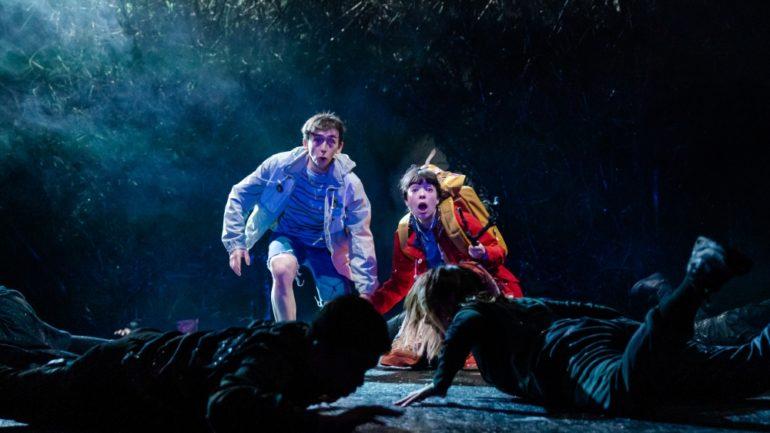‘The Ocean at the End of the Lane’: Theater Review
By David Benedict
LOS ANGELES (Variety.com) – Is Neil Gaiman’s “The Ocean at the End of the Lane” a story of childhood for adults or an adult view of the world for children? As director Katy Rudd’s astonishingly theatrical production of Joel Horward’s adaptation resoundingly proves, the answer is: Both. Although wisely recommended for audiences above the age of twelve – the age of the central character – this captivating piece of theater, now premiering at the National Theater in London, is as scary as it is splendid and as moving as it is, in every sense, magical.
As one would expect from the author of “Coraline,” Gaiman’s tale inhabits more than one world and does so with both wonder and fearful darkness. Death and loss stalk the piece, as is clear from an opening scene set at a cold funeral, immediately after which the bereaved father Alex (Justin Salinger) re-meets the strange and wise Old Mrs. Hempstock (Josie Walker), a pivotal figure from his childhood.
From there, he and the audience are catapulted back to the exact same place but on his 12th birthday. That moment, like the entire show, is charged with conflicting emotions, since this was the day when his bookish, awkward younger self, played with pained and touching restraint by Samuel Blenkin, discovered a dead body.
As motherless Alex attempts to sort out his jumbled emotions, a confident, knowing young girl, Lettie Hempstock (Marli Siu) appears. Teaming up with Alex, she take him home to her mother Ginnie (Carlyss Peers) and her grandmother (aka Old Mrs. Hempstock), all living in a house that has been there for centuries in the age-old woods.
So far, so fairy-tale, and as in all good fairy-tales, almost everything in the story is not what it seems. That’s certainly true of Lettie’s duckpond in the wooded garden (a creepy thicket designed by Fly Davis), which turns out to be an ocean not only of water but of time and space through which the two can travel. With more than a nod to Narnia, this is, among other things, a celebration of storytelling.
Thanks to extraordinary work by costume and puppet-designer, Samuel Wyer, puppet director Finn Caldwell and the typically imaginative movement work of Steven Hoggett (“Harry Potter and the Cursed Child,” “Curious Incident”), what the two of children find in that ocean is terrifying, all the more so because the design work feels, in the best sense, home-spun rather than manufactured. Still scarier is the infiltration of the other world’s many-limbed monster into Alex’s home and his family in the scarily sweet and reasonable persona of Ursula Monkton. Imagine Miranda Richardson as Mary Poppins and you’re only halfway to the horror.
Audible shivers ripple through the audience, wrapped around three sides of the open stage, as horribly smiling Ursula slips unexpectedly through doorways that vanish and reappear before everyone’s eyes. Her insidious and vicious control of the family’s minds – and the audience’s sensitivity to terror – is dramatized with perfectly judged simplicity.
In what is a spectacular National Theatre debut, Rudd’s conjuring of claustrophobia in an open space is seriously impressive. It’s typical of her unflashy control of every production element. Instead of marshaling a special FX jamboree, she makes the stagecraft visible, thus fashioning a production that demands and wins the audience’s imaginative complicity as Alex and Lettie wrestle with demons both physical and mental.
That’s exemplified in Paule Constable’s crepuscular lighting which, as ever, is profoundly suggestive rather than literal, determining mood and tone in ideal balance with the drive and doom of Jherek Bischoff’s music in Ian Dickinson’s vivid soundscape.
The teamwork extends through the cast, most of whom double up as ensemble, as in the strikingly staged arrival of the gleaming black hunger birds. But individual performances also gleam. Walker’s seemingly artless but fiercely affecting Old Mrs. Hempstock is quietly commanding while, faced with otherworldly events and life-and-death questions, Blenkin’s gawky Alex keeps the audience glued, and hold the story and its fantasy vs. reality metaphysics together.
Some of the early expository scenes lack pace, but the dramatic end of the first act leaves the audience agog. And the second act so fulfills expectations that the only question left unanswered is: When is the National going to bring this alarmingly good show back?

